





PHOTO GALLERY

Photos by Len Blumin
1. Red-eyed Duck
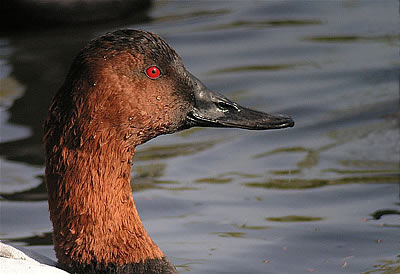
It's always striking to see a bird with a red eye. Iris color is quite variable in birds, ranging from white or silver to deep black, with a rainbow of colors in between. It is unclear just what purpose iris color serves, as it has little to do with vision. Perhaps something to do with species identification, but I haven't seen any credible explanation for the variations. That aside, a red iris is somewhat uncommon. We seen it in some Loons (Pacific, Comon) and Grebes (Horned, Eared), and of course some passerines like the Red-eyed Vireo and Phainopepla. Others include some Doves and Bulbuls. Among the ducks in North America, there are only three species with red eyes: Red-breasted Merganser (male), Cinnamon Teal (male) and Canvasback. Here we have the unmistakable profile of the Canvasback, Aythya valisineria, with a graceful slope from forehead to bill, and a traffic-stopping brilliant red eye.
Photo taken at Lake Merrit recently, which, by the way, if a great place to get close looks of Greater and Lesser Scaup, along with Canvasback, Common and Barrow's Goldeneyes, and others.
2. American Bittern
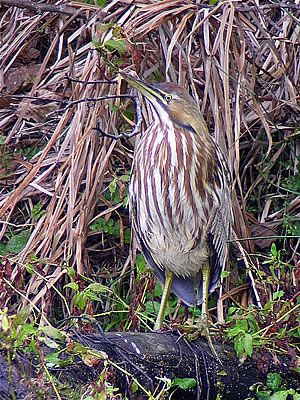
One of the highlights of our recent Holiday Bird Count (I'm starting a politically correct trend here) was the sighting of not one but two American Bitterns (Botaurus lentiginosus) at Muddy Hollow Pond near Limantour Beach. Both birds were in the open for quite a while, providing relaxed scope views for all, and a photo op for me. Bitterns are known for skulking amidst Cattails and Bullrushes, and standing rigidly with bill pointed skyward to allow their striped chests to blend with the foliage. Most books list them in the Ardeidae family (Herons, Egrets, Bitterns), but I couldn't find them in Hancock's "Herons and Egrets of the World". Turns out that a while back Bitterns were in their own family, and are still considered by some to be a "sub-family". They differ from Herons and Egrets by being shorter-legged and heavier bodied, and by their reclusive behaviour. Some have a modified esophagus to produce booming calls at dusk. American Bitterns look a lot like young Black-crowned Night-Herons. Note the green legs, black tips of the underside of the primaries, and the suggestion of a black patch on side of the neck, which would make it an adult. Taxonomy below.
Order: Ciconiiformes - Wading Birds.
Family: Ardeidae - Herons, Egrets and Bitterns - 65+ species in 21 genera.
Sub-family: Bitterns - 15 species in 4 genera. Besides the 4 below, we have Stripe-back, Black-backed, Schrenck's, Black, Dwarf, Cinnamon, Yellow, Least, Little, White-crested and Forest Bitterns.
Genus: Botaurus - Others here are the Great, Australasian and Pinnated Bitterns.
Species: Botaurus lentiginosus - American Bittern.
3. Hooded Mergansers
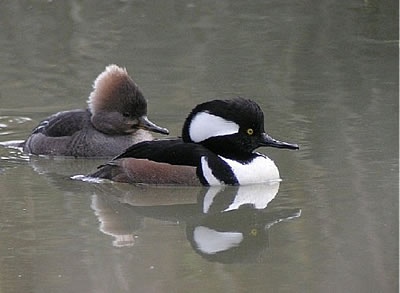
It's always good birding to find the more reclusive or less common birds. And then it's equally rewarding to find and watch beautiful birds. Hooded Mergansers (Lophodytes cucullatus) fill the bill on both accounts. They seem to prefer small quiet fresh water, either ponds or streams. We saw this pair in the slough that borders the south side of McInnis Park as you walk out the path towards the bay. Ducks seem an apt symbol for the New Year. They are usually paired up, or will be soon, and behave in charming fashion to each other. Oh, the males may squabble a bit in a show-off way to each other to win a new mate, but mostly we see them in a sedate courtship dance that varies with the species. But single or paired, the duck world seems to get along well with each other and the creatures around them. Would that our species could emulate them.
4. Phainopepla
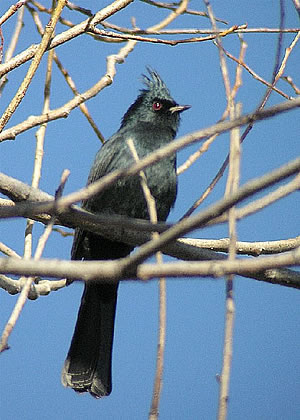
Watched a Phainopepla hawking insects at Solano Park the other day. Lot of mistletoe there.
5. Nuttall's Woodpecker (1)
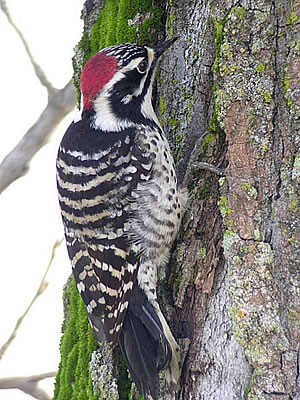
Thomas Nuttall was an Englishman who traveled extensively in the U.S. during the period 1810-1836. Primarily a botanist, Nuttall also loved birds and ended up writing the first real field guide for U.S. birds in 1831-32 ("A Manual of the Ornithology of the United States and Canada"). William Gambel, who later traveled with Nuttall, collected a new woodpecker species in California and named it Nuttall's Woodpecker, in honor of his renowned naturalist friend. (See Mearns "Audubon to Xantu's" for a great profile on Nuttall, and see also this page.)
Nuttall's Woodpecker (Picoides nuttalli) is virtually a California endemic, living usually near oak tree habitat from the coast to the foothills, and venturing barely into Baja California. Occasionally wanders to southern Oregon. Nuttall's Woodpecker stays year round in one area, loosely associated with its mate. The male has a red cap at the back of the crown and forages on the trunks of trees for insects, kind of like a Brown Creeper. The female forages on smaller branches. More in the next photo.
Sorry for the tight shot, but I couldn't easily back further away without blocking the parking lot entrance at Las Gallinas ponds.
6. Nuttall's Woodpecker (2)
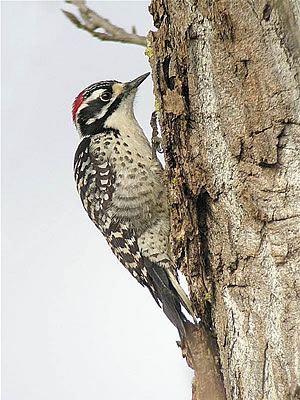
John James Audubon was a colleague of Nuttall, and named 2 new species in his friend's honor. The Common Poorwill (Phalaenoptilus nuttallii) was initially known as Nuttall's Whip-poor-will. The other was our endemic Yellow-billed Magpie (Pica nuttalli).
Nuttall's Woodpecker calls with a distinctive chatter as it flies, perhaps to let the mate know of its whereabouts. The fine black and white barring of the back is very similar to the Ladder-backed Woodpecker, but at the upper extent of the barring we can see a broad black bar which connects to a black stripe leading to the crown. The Ladder-backed lacks the broad black stripe. The ranges of these two Picoides species narrowly overlap in the southern california foothills, where they have been know to interbreed.
Note the fine bill, almost as small of the Downy Woodpecker. Here we also get a good look at the facial pattern, similar to that of some other Picoides.
7. Western Grebe
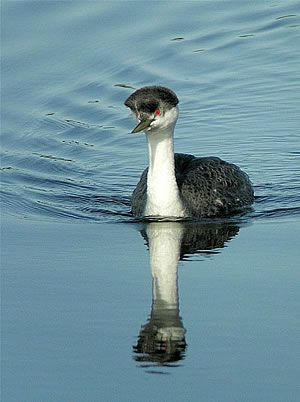
During the Christmas Bird Count this year we saw more Aechmophorus grebes than we could count, so of course we made the best estimates that time permitted. Nice to see such healthy populations of these graceful birds. There used to be just the "Western Grebe", with light phase and dark phase races, as in the first edition of the National Geographic Guide to Birds of North America. Not long thereafter the taxonomists decided that there were probably two distinct species in this genus, so it was split into Western Grebe (Aechmophorus occidentalis) and Clark's Grebe (A. clarkii). The Western Grebe shows less white at the waterline, sports a yellow-green bill (Clark's is orange), and has the eye surrounded by dark plumage ("eye in the black") most of the year. Sometimes we get a view of the rather interesting and crested-looking head, perhaps the last view seen by many a soon-to-be-eaten fish. Taken recently at Doran Beach, Bodega Bay, along the entrance road.
8. Barrow's Goldeneye
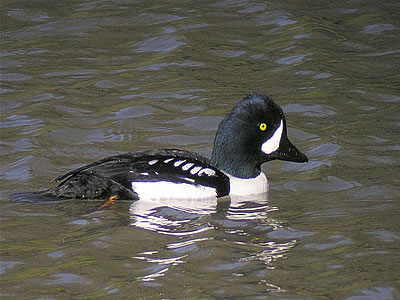
The extreme contrast between black and white on many ducks presents a technical challenge for the photographer, but delights the eye of the birdwatcher. Didn't want to leave you with blurred images of Goldeneyes, so I'll send this male Barrow's that we saw at Lake Solano (Putach Creek) recently. Handsome ducks, these. And "yes", Barrow's and Common Goldeneye can interbreed, but not frequently. Sibley shows such a hybrid. Other hybirds not listed for Barrow's, but Common Goldeneyes have hybridized with a wide variety of ducks, including Common Pochard, Greater Scaup, White-singer Scoter, Smew, Hooded Merganser and Common Merganser (see Palmer). Hey, maybe the Common Goldeneye in onto something with that "head-throw" thing.
(And I did consider the possibility that it is the female Common Goldeneye that is responsible for all that interbreeding, but the experts did not opine on that possibility.)
9. Common Merganser
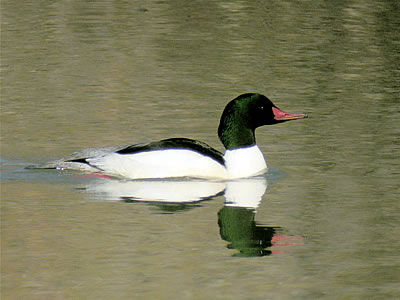
The Common Merganser (Mergus merganser) lives up to its name, in that it is probably the most common of the six or so merganser species in the world. They estimate that there about 1.3 million mergansers in North America, and during the Christmas Bird Counts about 73% of the mergansers tallied are Common. While Red-breasted Mergansers winter here in coastal waters, the Common Merganser is more at home on lakes and large streams. When they depart to breed, and they are one of the first ducks to leave in the spring, and head for forested areas in northern U.S. and across Canada. They need trees because they are cavity nesters. Identification of the male is easy, with a largely white body, white breast and a greenish head that snows no crest. And of course that big red serrated bill that serves well to catch slippery fish. The male Red-breasted Merganser (Mergus serrator) has a crest, gray flanks, dark breast and a thinner bill.
You can see the green sheen of the head better by looking at the reflection! The white is so intensely bright that taking a decent photo in the sun is virtually impossible with my gear, even with underexposing by 2 f-stops. Taken a few weeks ago on Putah Creek, Lake Solano.
10. Cormorant Portrait
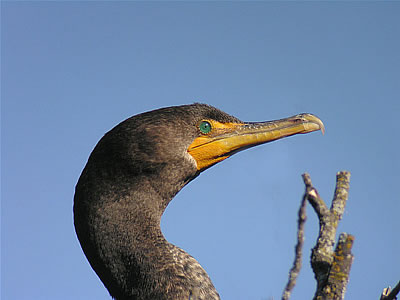
Cormorants spend a lot of time roosting somewhere near the water, either just drying wings or resting. Makes them good subjects for practising photographic technique. This one at Putah Creek recently, Lake Solano Park.
The Cormorant family is the largest family within the order Pelicaniformes, with 37 species worldwide. All are considered members of a single genus, Phalacrocorax. The larger ones usually have "cormorant" as part of their common name, but some of the smaller species have "shag" in their name instead. The Anhinga ("darter") is a close relative. The taxonomy discussion by Brinkley and Hannum in Sibley's Bird Life and Behavior, indicates that the cormorant family may be split in several genera. I have checked photos of a number of cormorant species and they all seem to have the same color iris, a beautiful turquoise that looks like a shallow tropical lagoon. Above is a portrait of a Double-crested Cormorant (Phalacrocorax auritius).
TOWHEE.NET: Harry Fuller, 820 NW 19th Street, McMinnville, OR 97128
website@towhee.net